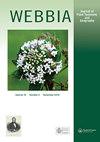Macrosolen zamboangensis (Loranthaceae), a new mistletoe species from Zamboanga Peninsula, Philippines
Q3 Agricultural and Biological Sciences
引用次数: 1
Abstract
Macrosolen zamboangensis, a new mistletoe species from the Zamboanga peninsula of the island of Mindanao (Philippines), is described. The new species is a member of the widespread M. melintangensis species complex, but differs from the previously described species in this complex in having a conspicuously papillose corolla head. It is also the only species in this complex that displays a combination of papillose pedicels, calycula and fruits, at least 3–4 inflorescence axes grouped at a node, and relatively small flowers that are clustered at the apex of a raceme (a subumbel) instead of being more evenly distributed along the inflorescence axis. The conservation status of this new species is considered Vulnerable (V).菲律宾三宝颜半岛槲寄生一新种——三宝颜寄生科
描述了棉兰老岛三宝颜半岛的一种新的槲寄生物种Macrosolen zamboangensis。该新物种是广泛分布的梅林坦根分枝杆菌物种复合体的一员,但与该复合体中先前描述的物种的不同之处在于具有明显的乳头状花冠头。它也是该复合体中唯一一个由乳头状花序蒂、杯状花序和果实组成的物种,至少有3-4个花序轴聚集在一个节上,相对较小的花聚集在总状花序(钻形花序)的顶端,而不是沿着花序轴更均匀地分布。这一新物种的保护状况被认为是脆弱的(V)。
本文章由计算机程序翻译,如有差异,请以英文原文为准。
求助全文
约1分钟内获得全文
求助全文

 求助内容:
求助内容: 应助结果提醒方式:
应助结果提醒方式:


